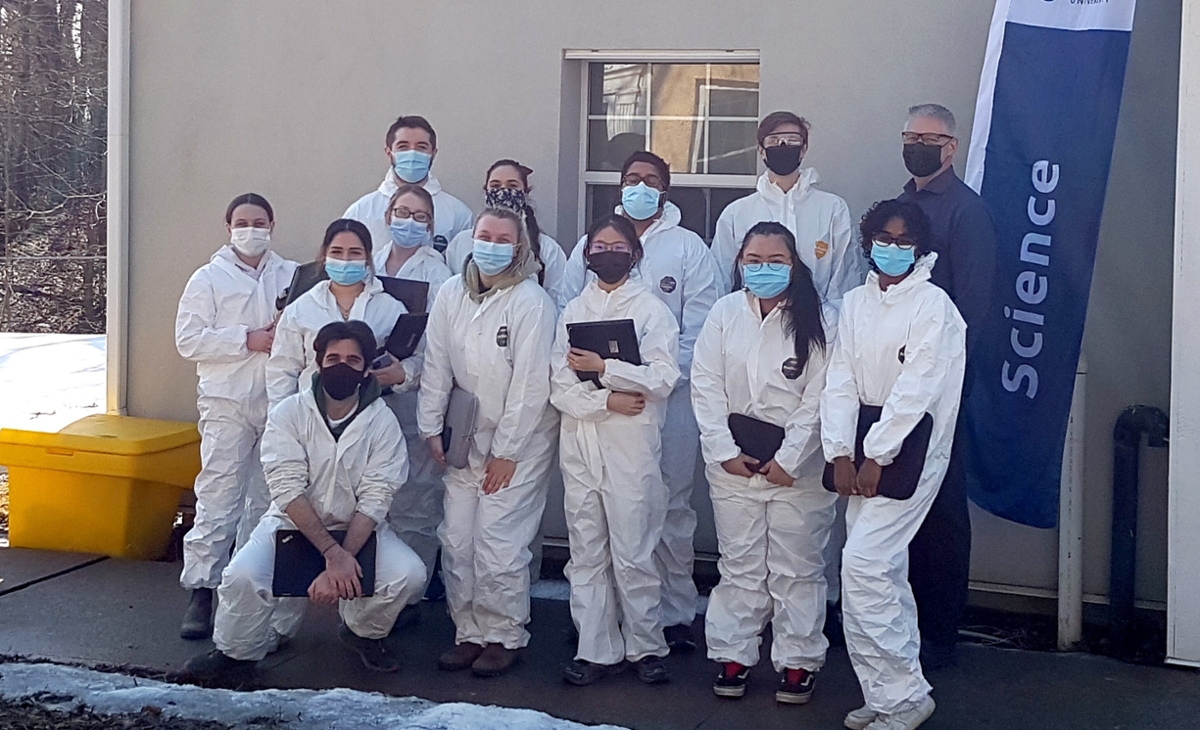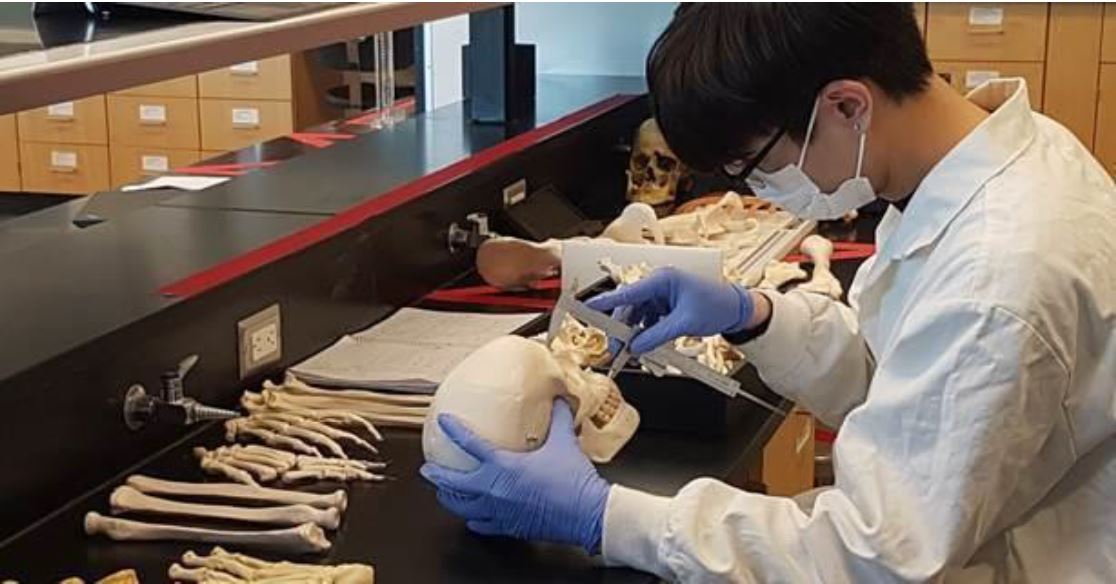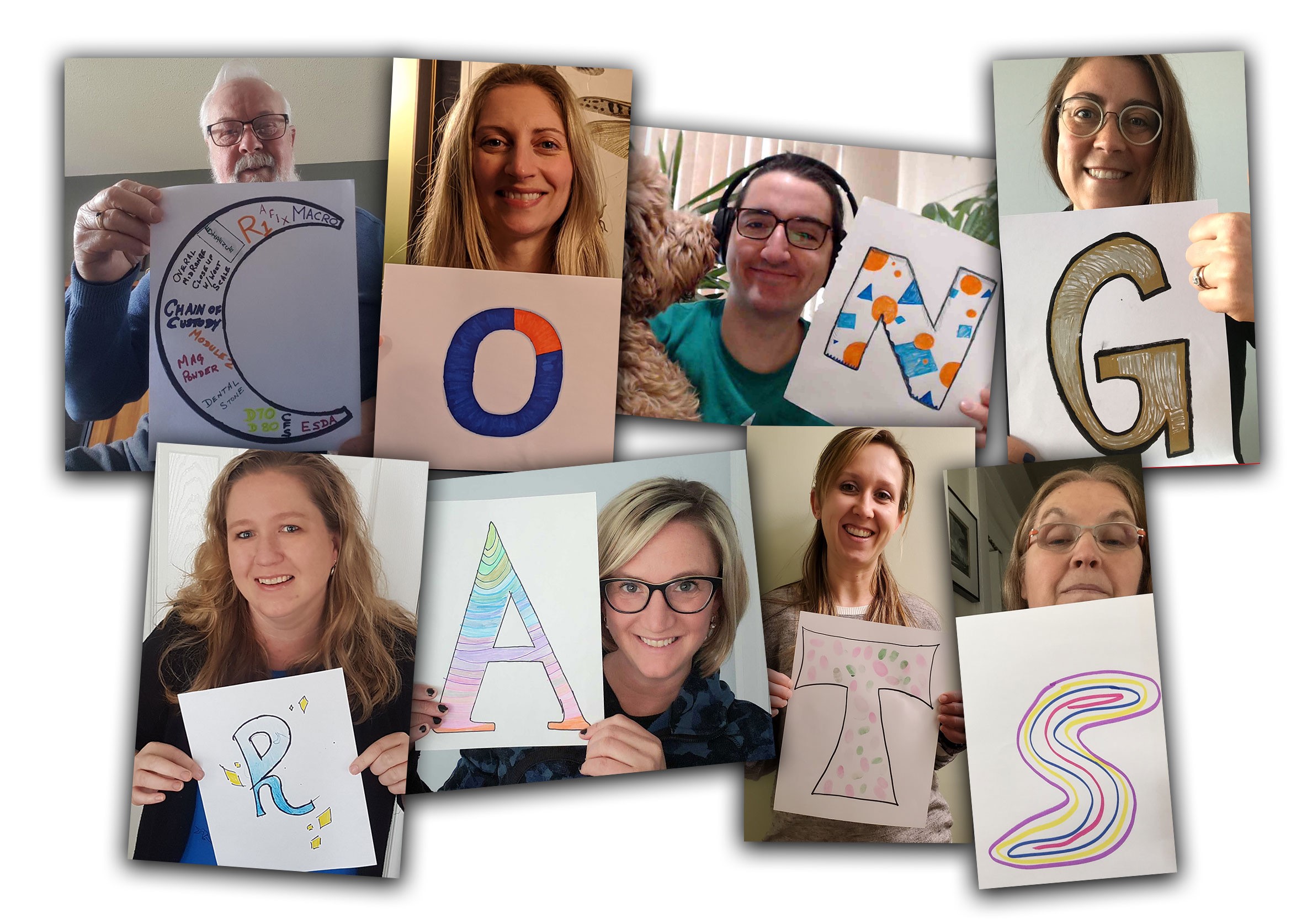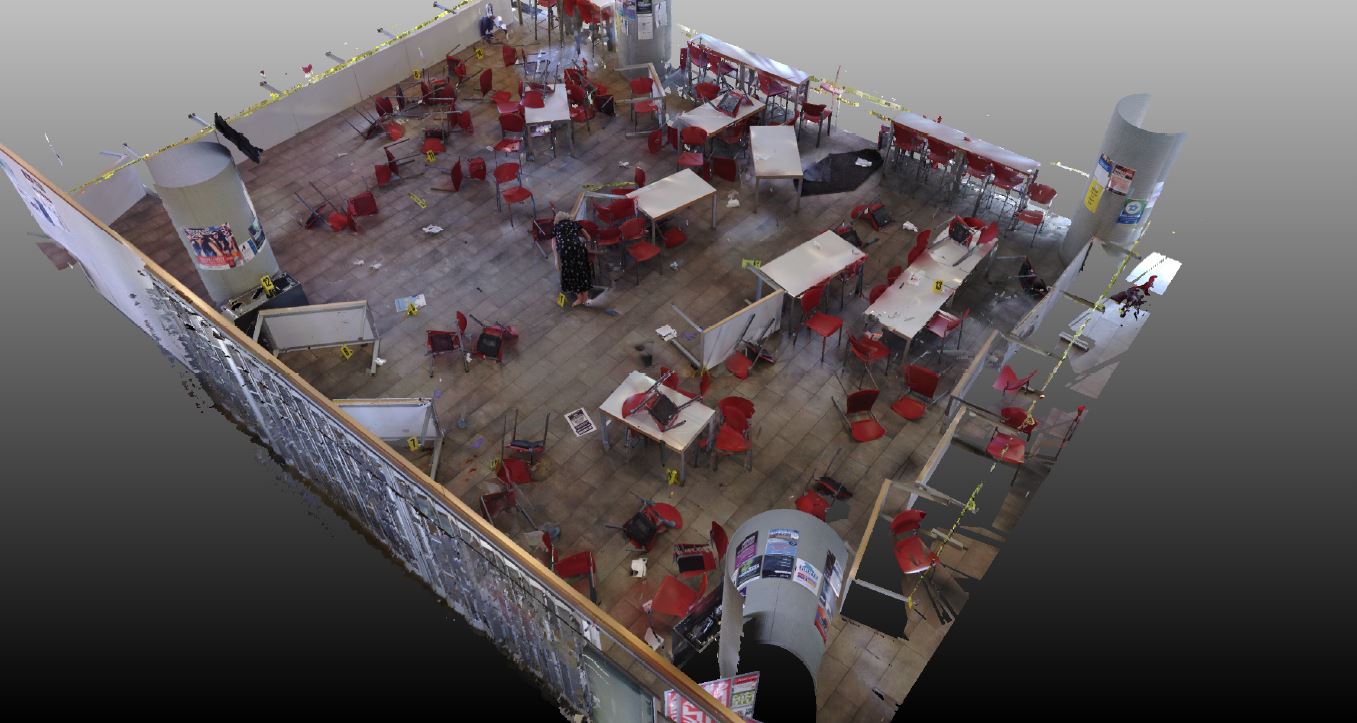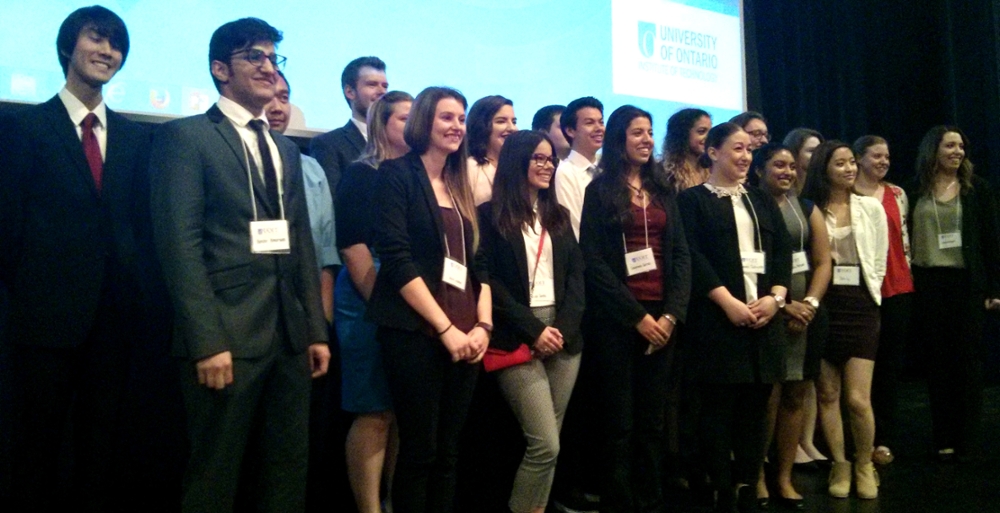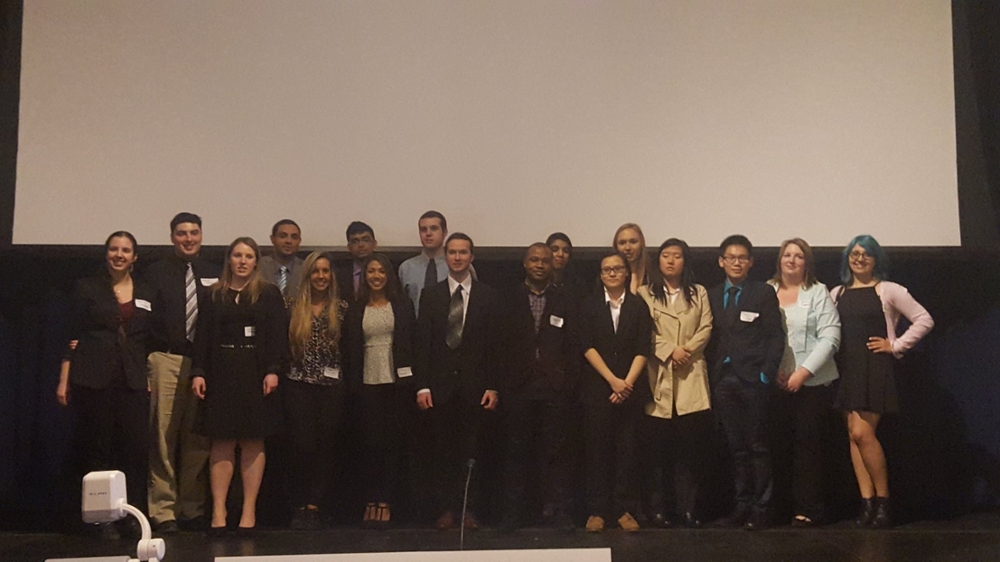Student achievement

Our Forensic Science program strives to maintain high standards of education and professional experience. A thorough assessment of the students’ abilities is integrated in course curriculum and measured in their final year through their capstone experience. Beyond graduation, the success of the program and the impact on the student is further assessed through exit and career surveys developed by the Forensic Science program and the university.
Forensic Science Students in the News
- https://www.artec3d.com/cases/3d-scanning-footwear-impressions-for-forensics
- https://www.guelphtoday.com/local-news/guelph-lab-helping-connect-remains-of-canadian-soldiers-killed-in-battle-with-family-5331209
- https://news.ontariotechu.ca/archives/2020/08/ontario-tech-students-capture-national-awards-from-the-canadian-society-of-forensic-science.php
Program Statistics
-
Retention and Enrollment Data (As of Oct. 2025)
Forensic Science Program Metric 1st Year Retention* Fiscal Full-Time Equivalents (FFTEs) Program Changes/Withdrawals 1st year Enrollment # of Graduating Students ** Switched into Forensic Science Switched out of Forensic Science Withdrew from Forensic Science 2012-13 70.6% 114.2 2 13 13 41 25 2013-14 73.6% 115.9 2 21 8 62 18 2014-15 73.6% 115.7 2 8 4 57 17 2015-16 76.0% 125.1 5 15 9 54 17 2016-17 81.1% 116.7 0 10 3 41 21 2017-18 77.8% 132.6 0 16 5 61 15 2018-19 72.7% 142.0 0 10 4 64 28 2019-20 84.6% 126.8 0 13 4 54 25*** 2020-21 77.1% 142.2 0 11 5 58 20*** 2021-22 78.9% 139.9 2 21 2 48 30 2022-23 77.6% 142.7 1 27 6 75 26 2023-24 71.4% 112.1 1 12 2 41 21 2024-25 - 121.9 - - - 49 - *Year 1 to Year 2 Retention, CSRDE methodology
**Graduates are counted for the calendar year (Jan - Dec)
***Students in Forensic Science & Management previously not included -
Alumni Employment Statistics (As of Oct. 2025)
Class
Total Students Forensic Science* FS Related Not FS Related Advanced Degrees No Contact 2009 15 3 20.0% 3 20.0% 4 26.7% 1 6.7% 5 33.3% 2010 11 2 18.2% 4 36.4% 1 9.1% 1 9.1% 4 36.4% 2011 14 2 14.3% 4 28.6% 4 28.6% 2 14.3% 4 28.6% 2012 15 3 20.0% 3 20.0% 1 6.7% 2 13.3% 8 53.3% 2013 27 4 14.8% 12 44.4% 4 14.8% 7 25.9% 7 25.9% 2014 16 2 12.5% 6 37.5% 3 18.7% 4 25.0% 5 31.3% 2015 18 3 16.7% 3 16.7% 6 33.3% 5 27.8% 4 22.2% 2016 16 2 12.5% 4 25.0% 5 31.3% 6 37.5% 3 18.8% 2017 19 1 5.3% 4 21.1% 4 21.1% 3 15.8% 7 36.8% 2018 16 2 12.5% 6 37.5% 1 6.3% 6 37.5% 2 12.5% 2019 30 2 6.7% 9 30% 10 33.3% 9 30.0% 5 16.7% 2020 22 4 18.2% 5 22.7% 4 18.2% 10 45.5% 2 9.1% 2021 18 0 0% 1 5.6% 3 16.7% 5 27.8% 9 50.0% 2022 31 2 6.5% 13 41.9% 6 19.4% 5 16.1% 9 29% 2023 26 0 0.0% 3 11.5% 8 30.8% 9 34.6% 8 30.8% 2024 23 1 4.3% 3 13.0% 11 47.8% 8 34.7% 6 26% 2025 32 - - - - - - - - - - Total (Not including Class of 2025) 317 33 10.4% 83 26.2% 75 23.6% 83 26.2% 88 27.7% *Individuals classified as having a forensic science job are those in the actual field of forensic science with respect to the relevancy of their degree obtained. Examples of this would be as follows: laboratory or fieldwork with forensic governmental/private agencies, etc. Those seeking careers in this field should be aware that background checks similar to those required for law enforecment officers are likely to be a condition of employment.
Publications
-
Journal articles
- Harvey J, Liscio E, Lowe A, and Stotesbury, T. (2024). Recovery of Footwear Impression Evidence Using Portable Three-Dimensional Scanning Technologies: A Pilot Study. Journal of Forensic Identification. 74 (1).
- Santangelo A, Liscio E, and Nugent K. (2023). Accuracy of Impact Angle Determinations from Bullet Holes in Drywall Panels. Canadian Society of Forensic Science Journal. https://doi.org/10.1080/00085030.2023.2169478
- Rampete, K., Elliott, C.I., and Stotesbury, T. (2023). Monitoring the solid-state VIS profiles of degrading bloodstains. Forensic Chemistry. May 2023;100507:1-9. https://doi.org/10.1016/j.forc.2023.100507
- Vale, B., Orr, A., Elliott, C., & Stotesbury, T. (2023). Optical profilometry for forensic bloodstain imaging. Microscopy Research and Technique, Oct 2023;86(10):1401-8. https://doi.org/10.1002/jemt.24338
- Elayas, M., Borsodi, M., Nugent, K., and Hamid, D. 2022. Enhancement of footwear impressions containing salt residue using silver nitrate and ultra-violet light. (accepted). Journal of Forensic Identification.
- Burns, P., Nugent, K., Gaspari, F., and Hendrikse,L. 2022. Using Momenum to Determine Serious Bodily Injury: An Experimental Study Using Pig Eyes (in press.) The Canadian Society of Forensic Science Journal. http://dx.doi.org/10.1080/00085030.2021.2016205
- Plante, J., Orr, A., Albrecht, I., Wyard, L., Boyd, P., Stotesbury, T. 2021. Passive drip stains formed on ice and snow: an observational study. Canadian Society of Forensic Science Journal. https://doi.org/10.1080/00085030.2021.1880726
- Dziak, R., Peneder, A., Buetter, A. and Hageman, C. 2018. Trace DNA Sampling Success from Evidence Items Commonly Encountered in Forensic Casework. Journal of Forensic Sciences. 64(3): 835-841. doi: 10.1111/1556-4029.13622
- Roloff, B., Buetter, A., and Adach, E. 2016. The recovery of latent fingerprints from paper using the Electrostatic Detection Apparatus®. Identification Canada. 39(4): 124-144.
- Forbes, S.L., Wilson, M.E.A., and Stuart, B.H. 2011. Examination of adipocere formation in a cold water environment. International Journal of Legal Medicine. 125(5): 643-650. DOI 10.1007/s00414-010-0460-6.
- Bissonnette, M., Knaap, W., and Forbes, S.L. 2010. Steam development of latent fingerprints on thermal paper. Journal of Forensic Identification. 60: 619-638.
- Comstock, J., Beeton, M., and Forbes, S.L. 2010. An investigation of barefoot morphology, friction ridges and their significance in forensic identification. Identification Canada. 33:4-19.
- Van Belle, L.E., Carter, D.O., and Forbes, S.L. 2009. Measurement of ninhydrin-reactive nitrogen influx into gravesoil during aboveground and belowground carcass (Sus scrofa) decomposition. Forensic Science International. 193: 37-41.
-
Book Chapters
-
LeBlanc, H.N., Perrault, K.A., Ly, J. (2020) Role of volatile organic compounds in chemical ecology. Chapter 24 pp 507-519, in Jason H. Byrd & Jeffery K. Tomberlin (eds.) Forensic Entomology: The Utility of Arthropods in Legal Investigations, Third Edition. CRC Press: Taylor & Francis Group
-
-
Conference presentations
- Maloney S, Shamsi M, Nugent K, Lafrenière NM, Banks R. Preliminary exploration of automotive carpet fibres for the development of a forensic database in Canada. Canadian Society of Forensic Science 2023 Conference, 14 June 2023, Ontario Tech University, Oshawa, ON, Canada (oral presentation).
- Kannan S, Lowe A, Stotesbury T. Characterizing a blood spatter impact device for practical research and training. Canadian Society of Forensic Science 2023 Conference, 14 June 2023, Ontario Tech University, Oshawa, ON, Canada (oral presentation).
- Lubrin D, Stotesbury T, Desaulniers JP. Synthesis and application of oligonucleotide bound alginate materials. Canadian Society of Forensic Science 2023 Conference, 14 June 2023, Ontario Tech University, Oshawa, ON, Canada (oral presentation).
- Lubrin D, Desaulniers JP, Stotesbury T*. Synthesis and application of oligonucleotide bound alginate materials. SOUSCC, Trent University, Peterborough, ON, Canada (oral presentation).
- Lubrin D, Stotesbury T, Desaulniers JP. Synthesis and application of oligonucleotide bound alginate materials. Ontario Tech University - Kyushu Institute of Technology mini symposium in chemistry. 28 October 2022 (oral presentation).
- Rampete K, Elliott C, Stotesbury T. Monitoring the short-term solid-state UV-Vis profiles of degrading bloodstains. Canadian Society of Forensic Science Twitter Poster Competition. 21 September 2022 (poster-presentation).
- Rampete K, Stotesbury T. Effects of temperature on the solid-state UV-Vis profiles of bloodstains. International Association of Bloodstain Pattern Analysts European Training Conference. 9 July 2022. (oral presentation)
- Vale B, Stotesbury T. Using optical profilometry to investigate changes in surface characteristics of degrading bloodstains. International Association of Bloodstain Pattern Analysts European Training Conference. 9 July 2022. (oral presentation)
- Fakhori M, Stotesbury T. Volatile Organic Compounds (VOCs) released from degrading bloodstains using SPME-GC-MS. Canadian Society of Forensic Science virtual conference – Forensic Science: A World of Opportunities. 21-24 June 2021. (poster presentation).
- Vir M, Nugent K, Carew RM, Cadola, L, Muehlethaler C, Falardeau M, Tanaka TA. A Study Into Additive Manufacturing to Clone Stamping Device Impressions. AAFS Annual Scientific Meeting 2021. February 2021. (Accepted.)
- MacMillan V, Nugent K, Foley R, Tanaka TA. Force Plate and High-Speed Video Analysis of the Stamping Device Application. AAFS Annual Scientific Meeting 2021. February 2021. (Accepted).
- Tiessen M, Fruehwald H, Burr W, Easton EB, Stotesbury T. Characterization of bloodstain films using differential pulse voltammetry (poster). The Canadian Society of Forensic Science Online Conference, 2020, Twitter.
- Kundan P, Stotesbury T. Passive drip stain formation on ice cold surfaces (poster). The Canadian Society of Forensic Science Online Conference, 2020, Twitter.
- Penny, K., and Nugent, K. Comparing the Effects of Different Writing Surfaces on Indentations Developed Using the Electrostatic Detection Apparatus (ESDA) (poster). The Canadian Society of Forensic Science Virtual Conference, 2020, Twitter.
- Borsodi, M., Nugent, K., and Hamid, D. The Enhancement of Footwear Impressions Containing Salt Residues Using Silver Nitrate (poster). The Canadian Society of Forensic Science Virtual Conference, 2020, Twitter.
- Burns, P., Nugent, K., Hendrikse, L., and Gaspari, F. Using Momentum to Determine Serious Bodily Injury: An Experimental Study Using Pig Eyes (poster). The Canadian Society of Forensic Science Virtual Conference, 2020, Twitter.
- Elayas, M., Nugent, K., and Hamid, D. Enhancement of footwear impressions containing salt residue using silver nitrate and ultra-violet light. Toronto Police Conference Forensic Training Conference. 2019
- Mortensen S, Fewkes M, Stotesbury T, LeBlanc HN. Entomotoxicology: Should it be used in Canada? (poster). The Canadian Society of Forensic Science Online Conference, 2020, Twitter.
- Ho, J., Skopyk, A., & LeBlanc H.N. (2020) Investigating Linkages Between Volatile Organic Compounds (VOCs), Total Body Scoring (TBS), and the Stages of Decomposition in Adult Pigs. Canadian Society of Forensic Science (CSFS) Poster Competition, Twitter. May 27
- Munro, D., Thang, S., Sainte-Marie, S., Blackmore, V., & Hageman, C. Body fluids and DNA on frequently handled and used objects. Canadian Society of Forensic Science Annual General Meeting, Gatineau, Quebec. May 2018.
- Gendi, M., & LeBlanc, H.N. The effect of developmental maturity of female blow fly Phormia Regina (Diptera: Calliphoridae) on EAG response to decomposition volatile organic compounds. Canadian Society of Forensic Science Annual General Meeting, Gatineau, Quebec. May 2018.
- Baptiste-Carmichael, T. Factors that affect the transfer and persistence of DNA on evidence items and surfaces. Canadian Society of Forensic Science Annual General Meeting, Gatineau, Quebec. May 2018.
- Ly, J. & LeBlanc, H.N. Electrophysiological response of Phormia Regina to cadaveric pig volatile organic compounds. International Association of Forensic Science (IAFS) Triennial Meeting, Toronto, Ontario. September 2017.
- LeBlanc, H.N. & Ly, J. Electrophysiological response of Phormia Regina (Diptera: Calliphoridae) to cadaveric pig Volatile Organic Compounds. North American Forensic Entomology Association (NAFEA), Davis, California USA. July 2017.
- Arnott, J., and Hageman, C. The indirect Transfer of “Touch” DNA onto a firearm via multiple intermediary steps. Canadian Society of Forensic Science Annual General Meeting, Montreal, Quebec. May 2016.
- LeBlanc, H.N., Buetter, A., Robinson, K. & Forbes, S.L. Evaluation of decomposition and insect colonization of pig (sus scrofa) cadavers inside a vehicle. 68th Meeting of American Academy of Forensic Science (AAFS). Las Vegas, Nevada. February 2016.
- Falconer, C., Ma, K., Nugent, K., and Gaspari, F. Creating a standardization variable to assist law enforcement in classification of firearms as either lethal or non-lethal. University of Ontario Institute of Technology Undergraduate Research Showcase, Oshawa, Ontario. August 2015.
- Giguere,E. The Influence of added weights on the morphology of barefoot impressions. Toronto Police Forensic Identification Training Conference, Toronto, Ontario. May 2015.
- Londero, V. Fibre transfer onto Knives after Penetrations through Fabric and Flesh. Toronto Police Forensic Identification Training Conference, Toronto, Ontario. May 2015.
- MacLean, B. Penetrating Capabilities of Air Guns: Analysis of Projectile Behaviour. Toronto Police Forensic Identification Training Conference, Toronto, Ontario. May 2015.
- Rolko, E. and LeBlanc, H.N. Assembly of an Electroantennogram and Isolation of Active Compounds Associated with Cadaver Decomposition Using Lucilia sericata (Diptera: Calliphoridae). 59th Conference of the Canadian Society of Forensic Science. Gatineau, Quebec. May 2014.
- Wou, S., Olson, G., Sainte-Marie, S., Nugent, K., and LeBlanc, H.N. The Effects of Extreme Temperatures due to Fire on Presemptive and Confirmatory Testing of Biological Fluid. 59th Conference of the Canadian Society of Forensic Science, Gatineau, Quebec. May 2014.
- Corbett, M., and Vallikanthan, T. K30 Breath Ethanol Concentration in Obese and Underweight Humans. 66th Annual Scientific Meeting of the American Academy of Forensic Sciences, Seattle, Washington. February 2014.
- Fazio, K., Auer, S., Nugent, K., Spencer, R., and Tanaka, T. The Effects of Constraint on a Signature's Static and Dynamic Features. 70th Annual American Society of Questioned Document Examiners Meeting. Charleston, South Carolina. August 2012.
- Michael R. Corbett, PhD, LLM*, and Andy Huang, BSc Comparison of Ethanol Elimination Rate of Human Females and Body-Paired Males. 64th American Academy of Forensic Sciences meeting, Atlanta, Georgia. February 2012.
- Peneder A., Renata Dziak, Kimberly Nugent and Jonathan Millman. Trace DNA Sampling Success Rates for a Evidence Items Commonly Encountered in Forensic Casework. 57th Annual Canadian Society of Forensic Science Conference. Toronto, Ontario. November 2010.
- Michael R. Corbett and Anu R. Singh, Sample Requirements (Pressure, Flow-Rate, Volume, Duration) of Investigated Breath Alcohol Test Devices (Alcotest 7410, Alert J5) and Instruments (Intoxilyer 5000/5000EN, Breathalyzer 900/900A, BAC Datamaster). Society of Forensic Toxicologists meeting in Richmond, Virginia. October 2010.
- Perrault, K., Hulse-Smith, L. and LeBlanc, H.N. A comparison of DNA collection techniques used in forensic casework. University of Ontario Institute of Technology Second Annual Graduate Student Research Conference. Oshawa, Ontario. May 2011.
- Forbes, S.L., LeBlanc, H.N., Perrault, K. and Buetter, A. Decomposition in a closed vehicle environment in southern Ontario. 63rd Annual Meeting of the American Academy of Forensic Sciences. Chicago, Illinois. February 2011.
- LeBlanc, H.N., Forbes S.L., Buetter, A., and Perrault, K. Study of Insect Colonisation Delay in a Closed Vehicle Environment. Canadian Society of Forensic Science – 57th Annual Conference. Toronto, Ontario. December 2010.
- Forbes, S.L., Stogran, M.A., and Carter, D.O. An investigation of amino acids in decomposition soil. 3rd International Soil Forensics Conference. Long Beach, California. November 2010.
- Forbes, S.L., Wilson, M.E.A., and Stuart, B.H. Examination of adipocere formation in Lake Ontario, Canada. 20th International Symposium on the Forensic Sciences. Sydney, Australia, September 2010.
- Buis, R. Devine, R. and Forbes, S.L. Using iodine silver plate transfer and a-napthaflavone for the development of latent fingerprints on skin. 2010 Toronto Police Forensic Identification Training Conference, Toronto, Ontario. March 2010.
- Bygarski, K. and LeBlanc, H.N. The Effects of Clothing on Decomposition and Insect Succession in a Southern Ontario Region. 2010 Toronto Police Forensic Identification Training Conference, Toronto, Ontario. March 2010.
- Caruana, B., Knaap, W. and Nugent, K. Recovery of DNA from chemically-treated fingerprints. 2010 Toronto Police Forensic Identification Training Conference, Toronto, Ontario. March 2010.
- Comstock, J., Beeton, M. and Forbes, S.L. Forensic Examination of Barefoot Morphology.2010 Toronto Police Forensic Identification Training Conference, Toronto, Ontario. March 2010.
- Van Osch, J., Chalmers, D. and Forbes, S.L. Detection of cleaning products and fingerprints with DPSS CW portable forensic laser. 2010 Toronto Police Forensic Identification Training Conference, Toronto, Ontario. March 2010.
- Stogran, M. A., and Forbes, S.L. Optimisation of a method to quantify amino acids in soil using HPLC-UV/Vis. 92nd Canadian Chemistry Conference and Exhibition, Hamilton, Ontario. June 2009.
- Forbes, S.L., Van Belle, L. and Carter, D.O. Measurement of ninhydrin-reactive nitrogen influx into gravesoil during decomposition. XXI Congress of theInternational Academy of Legal Medicine, Lisbon, Portugal. May 2009.
- Forbes, S.L., Lumley, T., Carter, D.O., and O’Brien, S.L.N. Succession of microfungi in gravesoil. 59th Meeting of the American Academy of Forensic Sciences, San Antonio, Texas, February 2007.
- Forbes, S.L., Nugent, K., McLeish, S., and O’Brien, S. The potential application of forensic mycology to the estimation of post-burial interval. Canadian Identification Society and Canadian Society of Forensic Sciences Conference, Windsor, Ontario. August 2006.
Capstone experience - Forensic Science Research Day
-
Overview
Mock Crime Scene Practicum
The focus of the Mock Crime Scene Practicum is to apply practical skills to process a complex crime scene. This is accomplished by simulating all the associated events a person may encounter from the crime scene to court. This includes extensive documentation of the scene, collection and identification of evidence, creation of detailed logs and forensic reports, and testifying as an expert witness in a mock court setting. Students selecting this capstone experience are expected to individually prepare a written report and collaborate on an oral presentation.
Directed Studies
The focus of the Directed Studies project is to identify gaps in the research literature. This is achieved by conducting a thorough literature review on a particular subject. Ultimately, the goal is to review the current state of the chosen field, leaving no stone unturned and putting current research into the broader context of forensic science. Students selecting this capstone experience have the opportunity to investigate the more diverse subject matter where conducting original research may be difficult. Students are expected to prepare a written document and a three-minute oral presentation.
Thesis Project
The focus of the Thesis Project is to fill the gaps in the research literature. This is achieved by reviewing previous studies, designing an experiment and conducting original examinations. Ultimately, the goal is to contribute novel research to a relevant field of forensic science or broader natural science. Students work closely with either internal or external supervisors who mentor them throughout the course of their work. Students selecting this capstone experience are expected to prepare a written thesis and oral presentation.
-
17th-annual Forensic Science Research Day - 2025
Click Here for Full Event Program
Graduating Class Photo
-
16th-annual Forensic Science Research Day - 2024
Click Here for Full Event Program
Graduating Class Photo
-
15th-annual Forensic Science Research Day - 2023
Click Here For Full Event Program
Graduating Class Photo
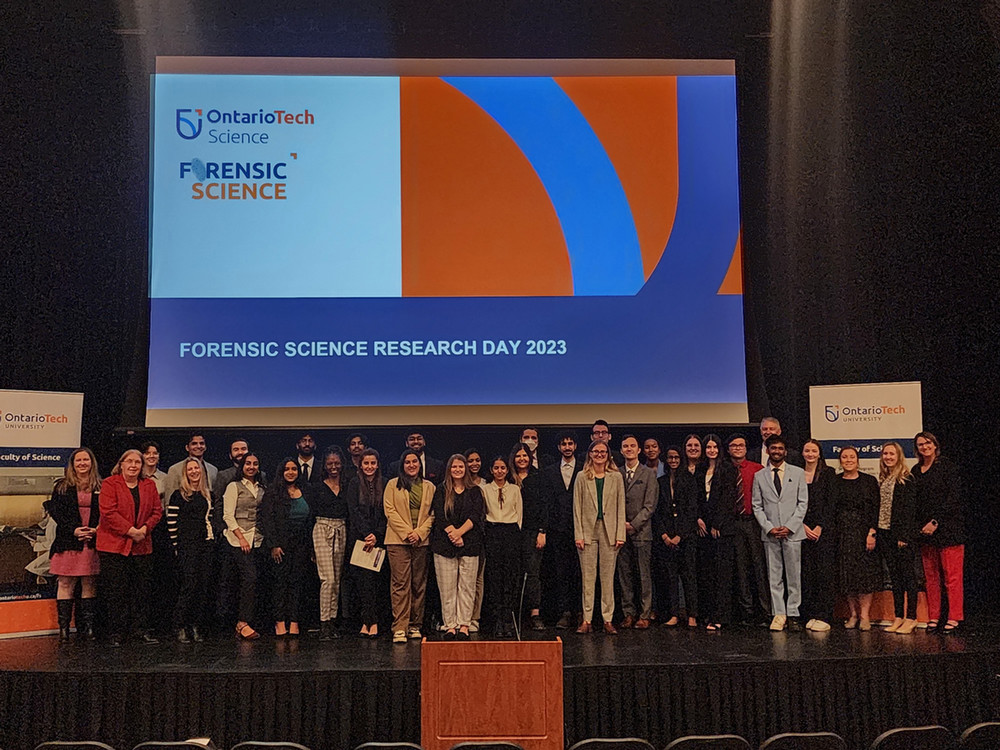
- 14th-annual Forensic Science Research Day - 2022
- 13th-annual Forensic Science Research Day - 2021
- 12th-annual Forensic Science Research Day - 2020
- 11th-annual Forensic Science Research Day - 2019
-
10th-annual Forensic Science Research Day - 2018
Click Here For Full Event Program
Graduating Class Photograph
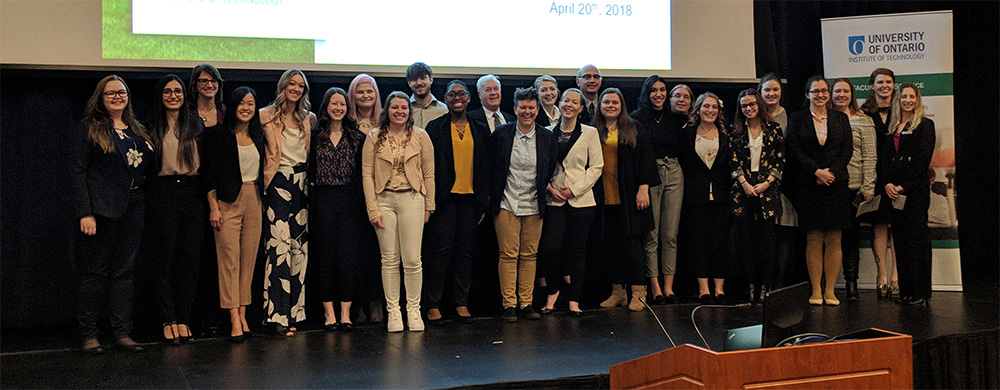
2018 graduating class with Forensic Science faculty members
View the Full Photo Gallery
- 9th-annual Forensic Science Research Day - 2017
- 8th-annual Forensic Science Research Day - 2016
